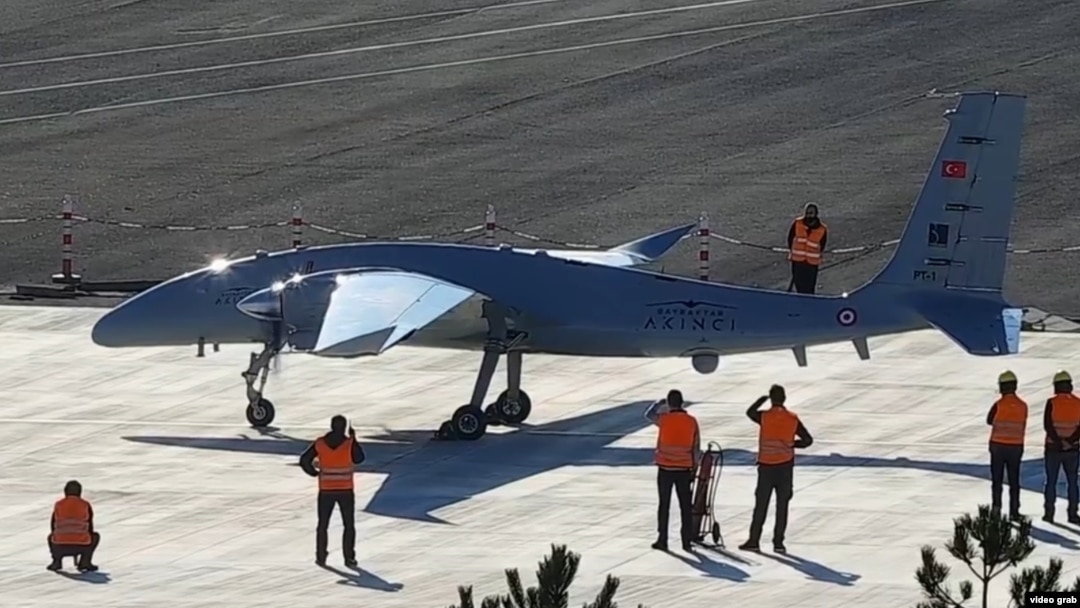Turkey says its Akinci drone deserves more credit for helping to locate the wreckage of the Iranian helicopter that crashed in a remote and mountainous area of Iran on May 19, killing President Ebrahim Raisi and other top Iranian officials, according to Turkish media reports on May 22.
The reports say that the Akinci drone was first to find the site of the wreckage and accused Iran of changing its narrative about the use of the Turkish equipment after it provided information about the location of the wreckage and then made counterclaims that its own drone found the site.
Turkish President Recep Tayyip Erdogan said earlier this week that the Akinci drone was sent at the request of the Iranian government.
According to Erdogan, despite the bad weather conditions the drone was able to conduct search operations in the region for seven and a half hours and fly a total of 2,100 kilometers.
After the Turkish drone identified the helicopter wreckage and detected heat sources believed to be the crash site in Iran’s East Azerbaijan Province, the Iranian search team successfully located the downed helicopter and the bodies of Raisi and the others in the mountainous terrain, according to Turkish media reports.
However, Iran rejected the notion that there was foreign participation in the search operation despite data from the Turkish drone that revealed the coordinates of the crash, and confirmation of this data by some Iranian news agencies.
After the Akinci drone captured images of the wreckage using its night vision and thermal camera and released them on the Internet, Pirhossein Kolivand, the head of the Iranian Red Crescent Society, called foreign participation in the search a rumor.
“We did not stop the search in the dark, fog, and rain, and when we discovered the wreckage of the helicopter with our own drone, we moved to the exact place where the helicopter fell," Kolivand said.
He claimed that rescuers from the Red Crescent found the wreckage at an altitude of 2,500 meters and "it took 40 minutes from the time of finding the wreckage of the helicopter to reaching the accident site.”
Your browser doesn’t support HTML5
New Pictures And Account Emerge Of Raisi Crash As Thousands Attend Funeral
But during the overnight search, the Red Crescent said in a statement at around 4 a.m. local time on May 20 that after the Turkish drone identified two potential “hot spots” the Red Crescent rescue teams headed toward the sites.
The head of the East Azerbaijan Red Crescent also cited the Turkish drone report that a “burning spot” had been detected and said rescue forces were sent to that area.
The head of Turkey, Asia, and Indo-Pacific studies at the Institute for International Relations and Strategic Research (ULISA) said in an opinion piece published by the state news agency Anadolu that the drone’s role in finding the wreckage site demonstrated the need to recognize Turkey’s commitment to fulfilling its humanitarian responsibilities through its defense capacity.
Professor M. Nazmul Islam said that, after Iran accepted Turkey’s offer to send the drone, the Akinci took off from a Turkish base at around 11:30 p.m. local time and began searching nearly an hour later. Turkey claims that it transmitted the image of the wreckage of the helicopter at 3:06 a.m. Iranian time and shared the coordinates with the Iranian authorities.
But according to Iranian media accounts, an Iranian drone belonging to the Quds Force of the Islamic Revolutionary Guards Corps found the remains of the helicopter at around 5:30 a.m. local time.
A statement issued by Iran's military said that, despite Turkey sending a drone equipped with night vision and thermal cameras, it "failed to accurately locate the crash site due to its lack of detection equipment and control points below the cloud," referring to the adverse weather conditions.
Iran Radio reported that it was “five o'clock in the morning when the correct coordinates were finally found with Iranian equipment and Iranian relief forces.”
Iran, whose military has its own drone program, was not able to deploy its drones because they were located in the northern part of the Indian Ocean at the time, the Iranian military said. Western powers have accused Iran of providing drones to Russia for its war in Ukraine.


